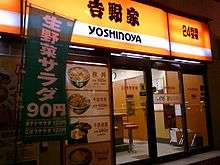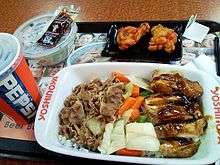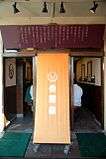Yoshinoya
 | |
| Industry | Foodservice |
|---|---|
| Founded | Tokyo, Japan (1899) |
| Founder | Eikichi Matsuda (松田栄吉) |
| Headquarters | Kita, Tokyo, Japan |
Key people | Shuji Abe, President and CEO |
| Products | Fast food |
Number of employees | 1,107 |
| Website | www.yoshinoya.com |
Yoshinoya (吉野家, TYO: 9861) is a Japanese fast food chain, and the largest chain of gyūdon (beef bowl) restaurants. The chain was established in Japan in 1899. Its motto is "Tasty, low-priced, and quick".[1] It has its headquarters in Kita, Tokyo.[2]
Etymology
The founder of the company, Eikichi Matsuda (松田栄吉), was from the former town of Yoshino (吉野町) in Osaka Prefecture, and there is a predominant belief that it is the origin of the name,[3] and the kanji 家 (ya) means "house." The kanji 吉 (yoshi) means "old" in Japanese and 野 (no) means "field."
The nickname of the restaurant is "yoshigyū" (吉牛), which is an abbreviation of Yoshinoya no gyūdon (吉野家の牛丼, Yoshinoya's gyūdon).[4]
The kanji of yoshi is slightly different from 吉 and has a part of 土 instead of 士, which is not included in standard Japanese computer fonts, while a Unicode number is assigned to it (𠮷).
Logo
The Logo of Yoshinoya is the “bull horn”, and was invented by Yoshinoya’s founder Eikichi Matsuda.The idea of the "bull horn" logo derived from the initial letter of Yoshinoya's English name "Y", while the rope surrounding the horn represents the "Yokozuna" ranking (winner) in Japanese sumo-wrestling, also representing the "Yokozuna" quality of our food. The surrounding rope is made up of 27 rice grains and the whole logo means Yoshinoya sells the "best beef bowls". “ [5]
History

Yoshinoya first opened in 1899 at the Nihonbashi fish market in Tokyo.[6] When the market was devastated by the Great Kantō earthquake, Yoshinoya moved to the new Tsukiji fish market in Tokyo in 1926.
The chain opened its first store that is open 24 hours in 1952.
On December 27th, 1958, the chain's business model was changed from self-employed restaurants to a stock company, as an attempt to gain more profit.
In 1965, the chain earned million dollars in sales, which led to the idea of expanding the chain's operations in Japan.
The chain's first franchised store was opened in Shinsaibashi, in 1968.
In 1975, the first American store of the fast-food chain was opened in Colorado.
In the early 2000s, Yoshinoya triggered a price war in Japan along with other chains such as McDonald's, by introducing a regular beef bowl dish for 280 yen, or around US$3.[7]
In late 2001, a domestic mad cow incident critically damaged beef bowl sales. In late 2003, Japan suspended imports of American beef due to a BSE incident in Washington State, cutting off Yoshinoya's main source of short plate (fatty beef) that is the main component of its beef bowl. This forced Yoshinoya to terminate beef bowl sales in Japan for the first time in its history on February 11, 2004. News of the removal of this item from Yoshinoya's menu caused its fans and non-fans alike to queue in massive lines at its restaurants all around Japan to taste what might be their last beef bowl for a long time. Yoshinoya then switched to serving pork bowl (butadon) instead of beef. On the other hand, its restaurants in the United States continued to serve the beef bowl using American short plate. From December 2, 2004, restaurants in Japan started serving "beef yakiniku bowls" (牛焼肉丼, gyū-yakiniku-don) which use Australian beef, different sauce and additional vegetables,[8] distinguished from original "beef bowls" that use American beef.
In December 2005, Japan agreed to remove the restriction on importing beef from the United States. A letter to customers was then put up in restaurants promising that the beef bowl would return in a couple months or so. In January 2006, imports stopped again because inspectors found banned cattle parts in a veal shipment from the United States. In June 2006, Japan lifted the ban on imports again, and on July 31, 2006, Yoshinoya re-posted the letter promising to resume serving the beef bowl in about two months.

On September 18, 2006, Yoshinoya brought back their beef bowl for one day as "the beef bowl revival festival" (牛丼復活祭, gyūdon fukkatsusai). This "revival", however, meant that its beef bowls would be available only the first five days of the month in October and November. On December 1, 2006, they began serving beef bowls daily, albeit at limited hours. These hours were extended once during special campaigns in February and December 2007. By March 17, 2008, Yoshinoya announced that they would resume 24-hour sales of the beef bowl, rolling out through their then 1040 stores nationwide through March 20, 2008. An announcement of banned cattle products in a Californian beef import on April 21, 2008, did not halt the company's plans, as they felt they had enough stock from other sources to avoid a recall.
Japan

In its restaurants in Japan, tables are often counters, and in that case they take orders over those counters. Chopsticks are ready to provide. The menu includes standard-serving (nami, or namimori, 並盛), large-serving (ōmori, 大盛), or extra-large-serving (tokumori, 特盛)[9] beef bowls, pork bowls (butadon, 豚丼),[10] raw eggs (to stir and pour on top, sometimes mixed with soy sauce), soft-boiled eggs (hanjuku tamago, 半熟玉子), miso soup and pickles (called oshinkō [お新香] in its menu; a kind of asazuke).[11] They also serve red ginger (beni shōga), spice, and Japanese tea (ocha, お茶) free of charge. Some menus including raw eggs and miso soup can be taken out.[11]
Some customers make special requests at no extra charge such as: extra gravy sauce (tsuyudaku, つゆだく),[12] extra onions (negidaku, ねぎだく),[12] without gravy sauce (tsuyunuki, つゆ抜き), no onions (neginuki, ねぎ抜き),[12] egg-yolk only (kimidake, 黄身だけ) and less rice (karui no, 軽いの; literally "light one").
On June 14, 2011, Yoshinoya in Japan started serving eel bowls (unadon, 鰻丼) as a standard seasonal menu to be offered until the latter part of July.[13]
Hong Kong
The Hong Kong division of Yoshinoya was founded in 1991. There are a total of 57 Yoshinoya food stores among three main areas: the Hong Kong branch, the New Territories branch, and the Kowloon branch. There are 14 stores in the Hong Kong branch, 21 stores in the New Territories branch, and 22 stores in the Kowloon branch. Each Yoshinoya food store has five working positions: store manager, supervisor, customer service assistant, crew, and production assistant.[5]
Healthy eating and affordable pricing
Recently, Yoshinoya in Hong Kong decided to not increase the prices of menu items, even though shipping prices have increased.
In an attempt to advocate what the chain considers healthy eating, Yoshinoya also designed a special meal plan, which was intended to target health-conscious customers.
The restaurant chain has also put forth a cheaper meal plan: $21 HKD for a main meal, $14.5 HKD for breakfast, and $15 HKD for high tea. In 2012, Yoshinoya promised they would not raise the prices for the main meal plan and the high tea plan from March to May.[14]
In 2009, Yoshinoya started delivering food to customers.
Since 2010, customers were also able to purchase food using an Octopus card, a card used to transfer electronic payments on or offline in Hong Kong.
Awards in Hong Kong
Yoshinoya has been awarded the “Quality Tourism Services-QTS” status by the Hong Kong Tourism Board since 2005 for the restaurant chain's excellent service to its customers.[15]
United States
Yoshinoya entered the United States market in 1973, opening its first location in Denver in 1975. It is currently present in California and Nevada. A location in Goodyear, Arizona opened in 2008 but was closed in December 2011. A Dallas location opened in June 2011 was Yoshinoya's first venture into Texas,[16] but it closed by December of the same year. The only location east of the Mississippi opened in Times Square, New York City in 2002 [17] but closed in January 2012. The main menu includes the beef bowl, chicken bowl, combo bowl, and shrimp bowl, along with soup and cakes, and has variations such as "beef with vegetables bowls", "teriyaki chicken bowls", and BBQ-style plates. Skinless chicken is available upon request. Their tempura bowls are no longer available. The menu of Yoshinoya in the US is similar to the menu in Japan. At a basic level both companies serve "stuff over a bowl of rice", which includes the trademark beef bowl with very thinly sliced beef with light sauce and onions.
Locations

Yoshinoya has a chain of stores in Japan, the United States, Hong Kong, Cambodia, China, Indonesia, Malaysia, Philippines, Singapore, Taiwan and Thailand.
Gallery
 Yoshinoya in Teradachō, Osaka city, on September 18, 2006
Yoshinoya in Teradachō, Osaka city, on September 18, 2006 The flagship restaurant in Tsukiji fish market in Tokyo
The flagship restaurant in Tsukiji fish market in Tokyo- Greetings to customers at the flagship restaurant
 Free banner given to customers in "the beef bowl revival festival" on September 18, 2006
Free banner given to customers in "the beef bowl revival festival" on September 18, 2006
References
- ↑ http://www.yoshinoya.com/ (Retrieved on April 7, 2010)
- ↑ "会社概要." Yoshinoya. Retrieved on October 30, 2013.
- ↑ "吉野家の歴史に関するご質問." (Japanese) YOSHINOYA CO., LTD. Retrieved July 6, 2011.
- ↑ Wikipedia contributors. "吉野家." Wikipedia: Japanese language version. June 22, 2011, 03:38 UTC. Retrieved July 6, 2011.
- 1 2 Hong Kong Yoshinoya official website: "Archived copy". Archived from the original on October 11, 2012. Retrieved October 4, 2012.
- ↑ http://www.yoshinoya.com/shop/tsukiji/ (Retrieved on April 10, 2010)
- ↑ Nagata, Kazuaki (2014-04-28). "No sacred cows in Japan's beef bowl war". The Japan Times Online. ISSN 0447-5763. Retrieved 2015-10-06.
- ↑ Press release "Archived copy" (PDF). Archived from the original (PDF) on May 22, 2011. Retrieved April 10, 2010. (Retrieved on April 10, 2010)
- ↑ "吉野家メニュー: 牛丼・牛皿." (Japanese) YOSHINOYA CO., LTD. Retrieved July 6, 2011.
- ↑ "吉野家メニュー: 豚丼・豚皿." Archived July 9, 2011, at the Wayback Machine. (Japanese) YOSHINOYA CO., LTD. Retrieved July 6, 2011.
- 1 2 3 吉野家の牛丼、頼み方は72種類 (2008). Retrieve June 19, 2011, from http://www.gamenews.ne.jp/archives/2008/03/72_1.html
- ↑ "吉野家 夏の定番メニュー 「鰻丼」期間限定発売のお知らせ." (Japanese) (pdf) YOSHINOYA HOLDINGS. June 9, 2011. Retrieved July 5, 2011.
- ↑ News from Hong Kong Yoshinoya official website: "Archived copy". Archived from the original on January 13, 2013. Retrieved October 4, 2012.
- ↑ Quality service:"Archived copy". Archived from the original on August 30, 2012. Retrieved October 4, 2012.
- ↑ "Archived copy". Archived from the original on May 19, 2011. Retrieved May 24, 2011.
- ↑ "Yoshinoya". Retrieved 23 December 2015.
External links
| Wikimedia Commons has media related to Yoshinoya. |
- (Japanese) YOSHINOYA CO., LTD.
- (Japanese) YOSHINOYA HOLDINGS CO., LTD.
- (English) YOSHINOYA America
- (English) YOSHINOYA Singapore
- (Chinese) YOSHINOYA Hong Kong
- "Yoshinoya: The Videogame - Video Review" at "BN-Games.com (English)